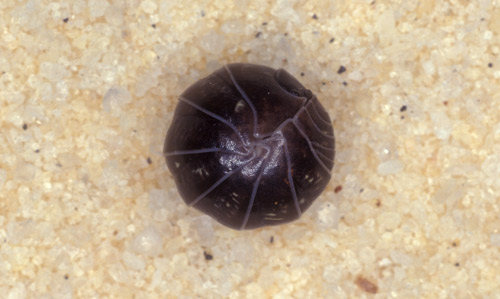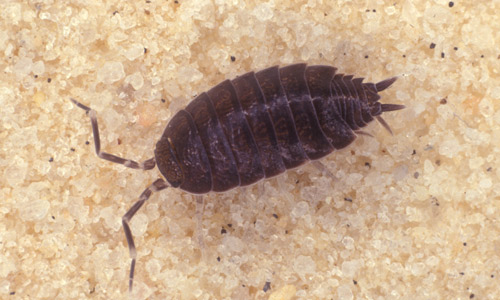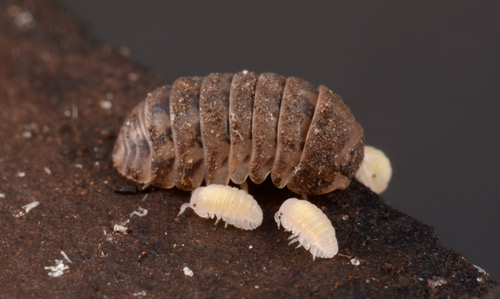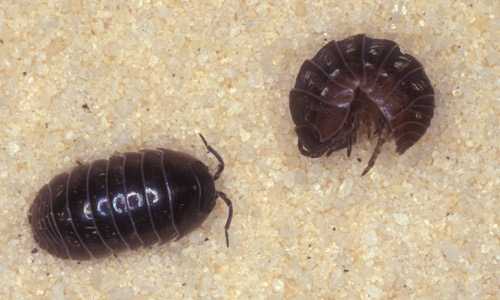common name: pillbug, roly-poly, woodlouse
scientific name: Armadillidium vulgare (Latreille) (Malacostraca: Isopoda: Armadillidiidae)
Introduction - Distribution - Description - Life Cycle - Host Plants - Management - Selected References
Introduction (Back to Top)
The pillbug, Armadillidium vulgare (Latreille), is an isopod, a type of non-insect arthropod also known as a terrestrial crustacean. It is sometimes called a roly-poly due to its ability to roll into ball when disturbed (Figure 1). This defensive behavior also makes it look like a pill, which is why it is sometimes known as a pillbug. The name woodlouse is used for both pillbugs and sowbugs in Europe and refers to where these arthropods are found, such as under logs. Pillbugs are nocturnal, though they may be found during the day in the soil or under debris. They are mainly beneficial in the garden or landscape, but can become occasional pests if they wander indoors.
Figure 1. Pillbug, Armadillidium vulgare (Latreille), rolled into a ball. Photograph by James Castner, University of Florida.
The pillbug is often mistakenly referred to as a sowbug, which is the common name used for other species of woodlice in the genera Oniscus and Porcellio. Sowbugs and pillbugs are both isopods, but they differ in that a pillbug can roll into a ball and a sowbug cannot. Sowbugs are more flattened and have appendages extending from the last abdominal segment that prevent them from rolling (Figure 2).
Figure 2. A sowbug, another non-insect arthropod that is often mistaken for the pillbug, Armadillidium vulgare (Latreille). Photograph by James Castner, University of Florida.
Distribution (Back to Top)
Pillbugs were introduced from Europe and are found throughout the world as a cosmopolitan species.
Description (Back to Top)
Pillbugs are nocturnal isopods. During the day they can be found in dark, humid places such as under fallen leaves, rocks, or logs. They are terrestrial crustaceans that live their entire lives on land. Pillbugs feed mainly on decaying plant leaves and other decomposing materials.
Life Cycle (Back to Top)
Eggs: The eggs are carried in a marsupium (brood pouch) on the ventral (underside) surface of the female and can reach a diameter of 0.7 mm. Eggs hatch after three to four weeks. Females may produce one to three broods every year and each brood is composed of 100 to 200 eggs.
Young: After hatching, the young may stay in the pouch on their mother’s underside for an additional one to two weeks and grow to 2 mm in length before venturing off on their own. While in the marsupium, both the eggs and the young survive on nutrients received through marsupial fluid (Capinera 2001).
Figure 3. Pillbug, Armadillidium vulgare (Latreille), adult and young. Photograph by Lyle J. Buss, University of Florida.
The young’s first molt occurs within a day after leaving their mother. This first molt allows them to gain the seventh segment of their pereon (the thoracic structure in crustaceans). The second molt takes place two weeks later and allows the seventh pair of legs to generate, originating from the newest thoracic segement. The pillbugs continue to molt every one to two weeks for the next 18 weeks. When molting, the posterior portion of the body sheds first and then the anterior portion sheds around three days later (Capinera 2001).
Adult: The adult ranges in color from gray to brown and reaches 8.5 to 18 mm in length when mature (Capinera 2001). The head has one pair of antennae and a pair of antennules, both used to detect sensory stimuli from the pillbug’s environment. Compound eyes are located on the side of the cephalothorax (the head-like region in isopods composed of the fused head and thoracic segment) (Figure 4). The body of Armadillidium vulgare is made up of a thorax (known as the pereon) with seven segments and an abdomen (the pleon) with uropods (appendages arising from the last segment of the abdomen). Pillbugs have seven pairs of legs, one pair for each segment of the thorax. Males and females can be distinguished by looking at the ventral (underside) plane. Males have copulatory organs on the anterior portion of the thorax and females have a pouch for brooding (the marsupium), if they are pregnant. Adults can live for two to five years.
Figure 4. Pillbug adults, Armadillidium vulgare (Latreille). Photograph by James Castner, University of Florida.
Host Plants (Back to Top)
The pillbug’s main habitat is under mulch, fallen leaves, and rocks. Pillbugs are nocturnal and require humid conditions during the day. Pillbugs are generally found in soil with sowbugs, millipedes, and earthworms. Their preferred soil habitat is composed of organic matter and has a neutral to alkaline pH. Pillbugs are least likely to be found in soil that has been tilled, is too wet, or has an acidic pH (Capinera 2001). Pillbugs have also been found feeding on seedlings and some plant roots, leading to occasional minor pest status.
Plants with damage to green leaves by Armadillidium vulgare (Latreille) include Picris echioides and Silybum marianum in the grasslands of California (Paris 1963). Additionally, Armadillidium vulgare (Latreille) was found to cause damage to tomato, radish, lettuce, mustard, pea, and bean crops (Pierce 1907). Armadillidium nasatum has been reported feeding on cucumber plants and fruit (Goats 1985).
Economic Importance and Damage (Back to Top)
A study was conducted on the effects of the detritivorous behavior (consumption of dead plant material) of the pillbug in the hydric hardwood forest of central Florida. The pillbugs’ foraging had a positive impact on the ecosystem, shown by increased mineral layer nutrients (nitrogen, phosphorous, and potassium), increased pH, and higher amounts of carbon eliminated from fallen leaves (Frouz 2008).
Pillbugs may also be found inside of homes, but are not known to cause any damage, only annoy people by being present inside their residences.
Management (Back to Top)
Preventing the establishment of pillbugs in unwanted areas is the best management strategy. Pillbugs traveling inside a home can easily be swept up and taken outside. To prevent their re-entry, ensure any floor level cracks and door entries are sealed. Cultural controls for preventing pillbugs from causing damage to seedlings or vegetables and fruit on the soil, may include avoiding overwatering leading to moist soil conditions and removing decaying plant material that may serve as a host area for the isopods. Chemical controls include insecticide bait, dust, granular, and liquid formulations (Capinera 2001).
Selected References (Back to Top)
- Beck ML, Price JO. 1985. Genetic variation and differentiation in Armadillidium vulgare (Isopoda: Oniscoidea). Genetica 66: 169-171.
- Capinera JL. 2001. Handbook of vegetable pests. Academic Press, San Diego.
- Frouz J, Lobinske R, Kalcik J, Ali A. 2008. Effects of the exotic crustacean, Armadillidium vulgare (Isopoda), and other macrofauna on organic matter dynamics in soil microcosms in a hardwood forest in central Florida. Florida Entomological Society 91: 328-331.
- Howard HW. 1980. The distribution at breeding time of the sexes of the woodlouse, Armadillidium vulgare (Latreille, 1802) (Isopoda). Crustaceana 39: 52-58.
- Koehler PG, Pereira RM, Allen RA. 2012. Pillbugs, sowbugs, centipedes, millipedes and earwigs. UF/IFAS. ENY-221. (26 May 2020).
- McDaniel EI. 1931. Insect and allied pests of plants grown under glass. Michigan Agricultural Experiment Station Special Bulletin No. 214.
- McDaniel, E. I. 1924. Greenhouse insects. Michigan Agricultural Experiment Station Special Bulletin 134: 52.
- University of California Integrated Pest Management Online. 2013. Managing pests in gardens: Fruit: Invertebrates: Sowbugs and pillbugs UC IPM. (26 May 2020).
- Ziegler A, Suzuki S. 2011. Sperm storage, sperm translocation and genitalia formation in females of the terrestrial isopod Armadillidium vulgare (Crustacea, Peracarida, Isopoda). Arthropod Structure and Development 40: 64-76.



